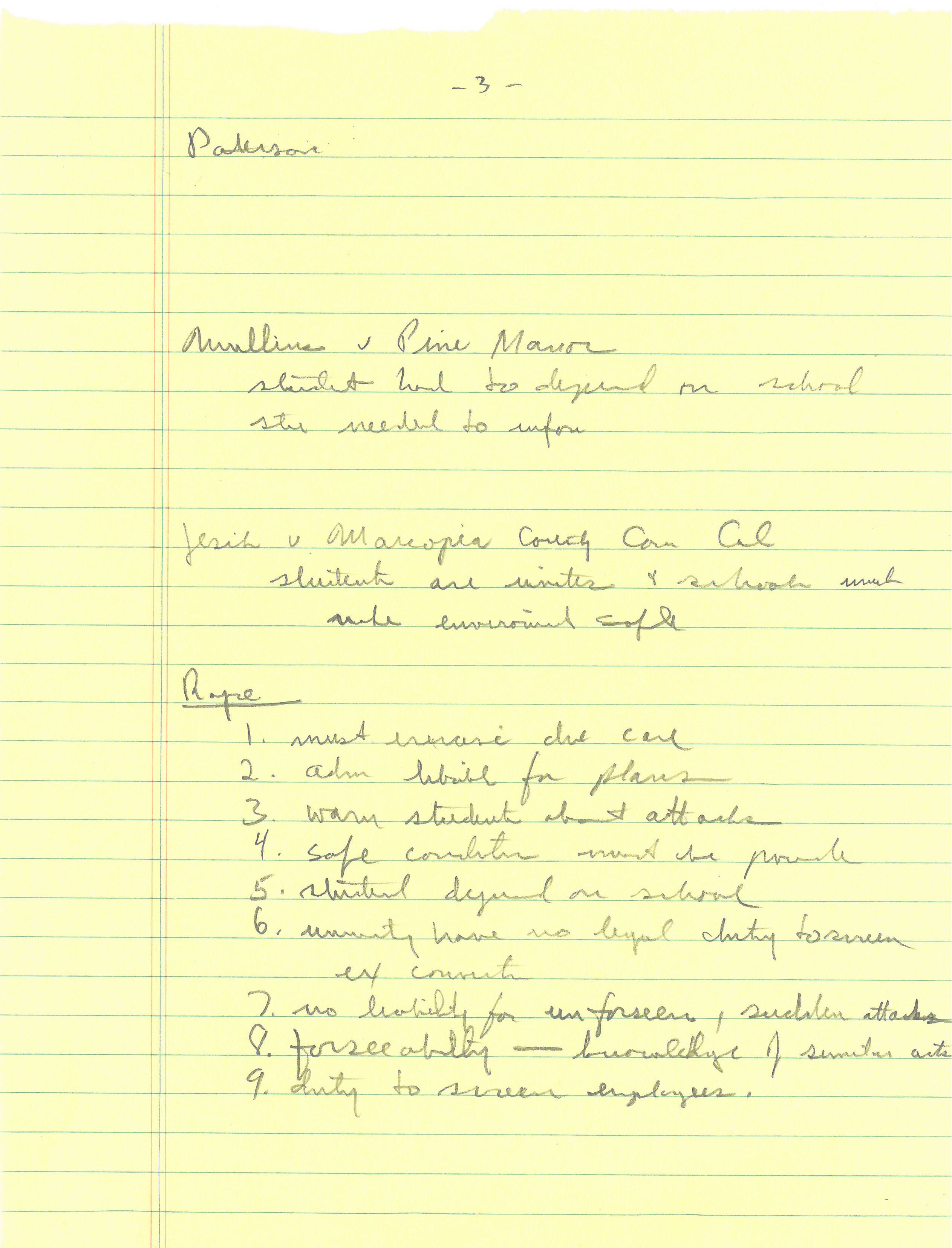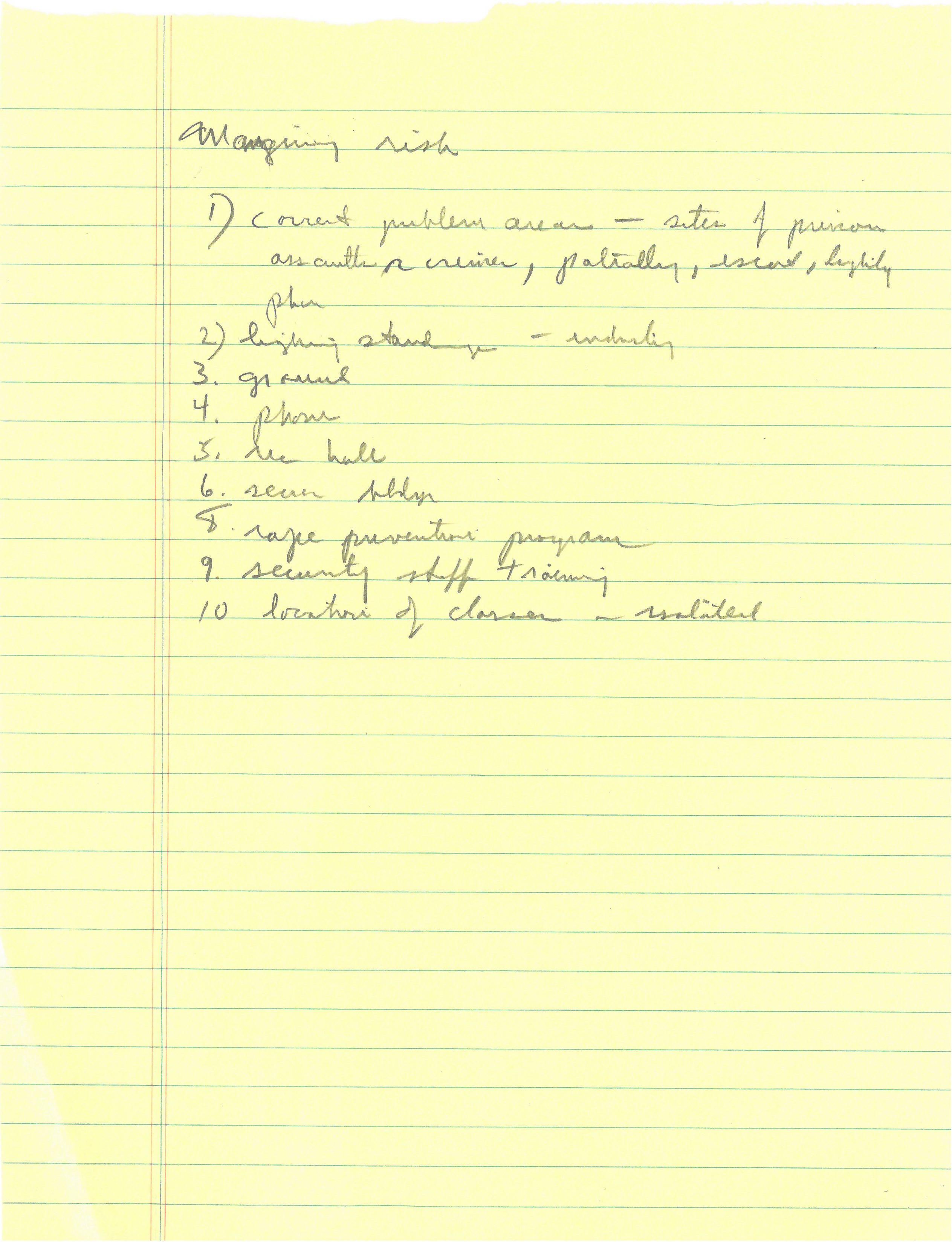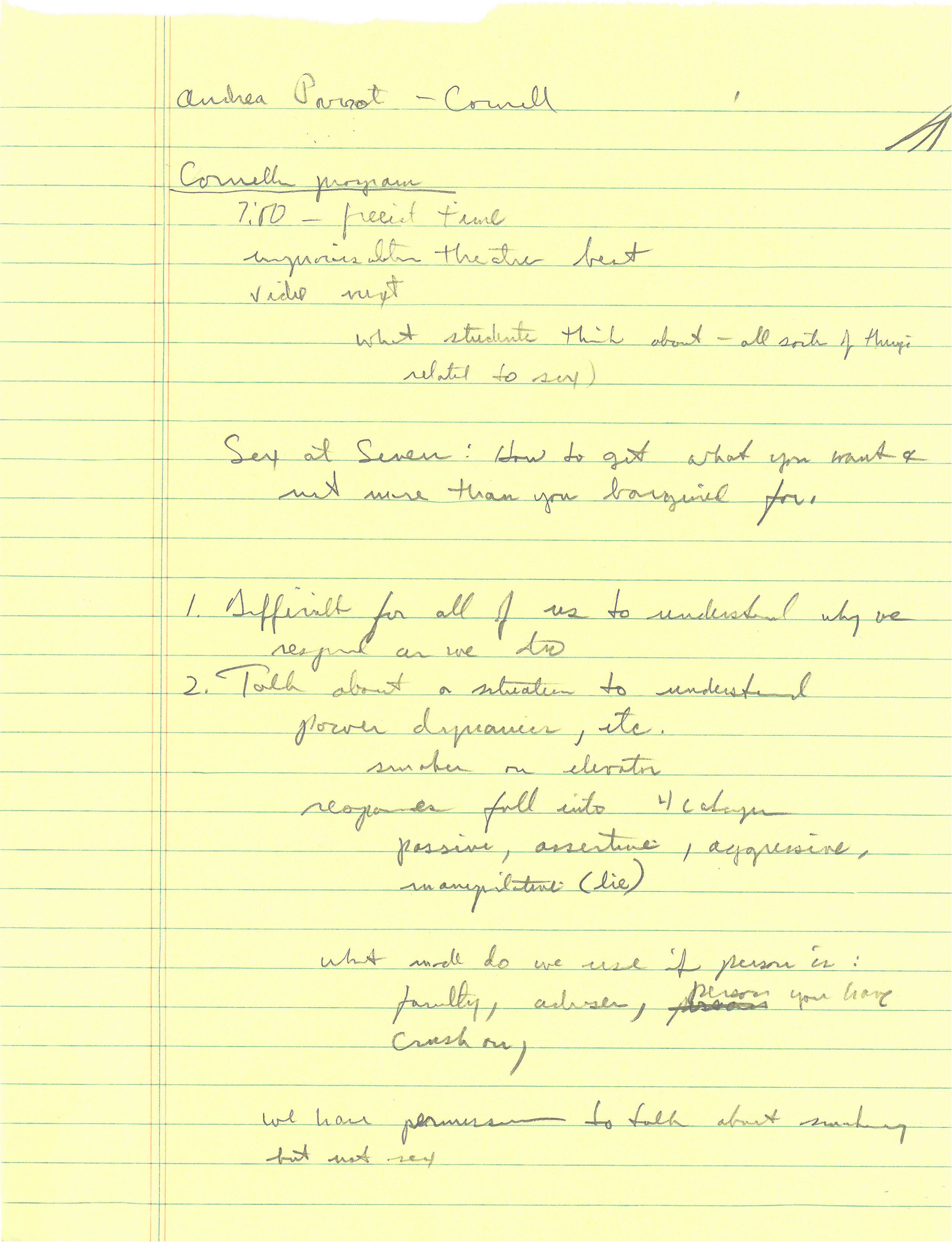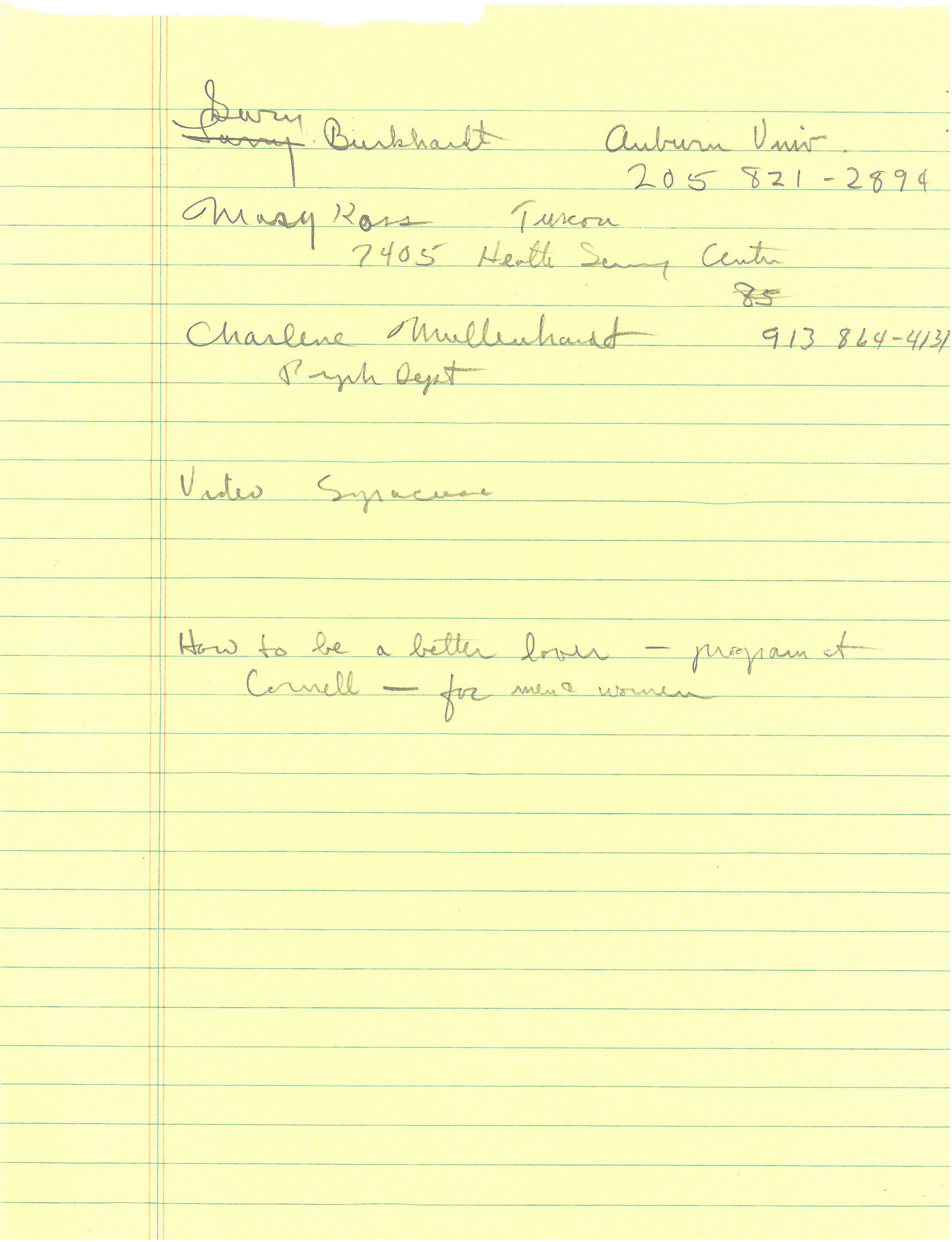|
|
Transcription: File in Rape Conference Material[2]
Security- to provide a safe environment group rape – for me this might be thought of as aggrevated [sic] rape – [complications?] behavior ______________ Liability Torts – a civil wrong[3]
Liability- responsibility for actions -direct or indirect [inserted above line: 4 tests] 1st – must be a duty owed – do we [owe?] security? 2nd – breach of duty 3rd “ must cause incident 4th There is an injury that is result of event.
Standard of Court – reasonableness [a doodle is in the margin]
Foot ball [sic] spectator (haven’t invited, but they ca [sic] [squiggles] 3) trespasser – owe them nothing, except may not hurt them —-> __________________________________________________________________________________ Avoiding Rape On & Off Campus – by Carol Pritchard[4] [illegible] N [illegible] -CIT – [illegible illegible] for Stu[dent] Affairs
-2-
Foresee ability [sic] – could anticipate reasonable person –
neglent [sic] defenses
act or omission
compare both parties as to degree of responsibility
Vicarious liability A is responsible; B has a relationship director of security responsible for his officer behavior
Bench mark [sic] case Duarte vs State of Calif.[5] a- knowledge of high rate of crime & no response b- contractually obligate [sic] to provide safe en[6] c- false representation as safe Miller v State of N. Y.[7]
Same a b & c above [sic] -3-
[Paterson?]
Mullins v. Pine Manor[8] Student had to depend on school stu[dent] need to [inform?]
Jesih [sic] v. Maricopia County Con Cal [sic][9] Students are invitees & school must make environment safe
Rape
Managing risk
Andrea Parrot – Cornell[10]
Cornell program 7:00 -freeist [sic] time improvisation theatre best video next What students think about- all sorts of things relate to sex)
Sex at Seven:[11] How to get what you want & not more than you bargained for.
Power [disparities?], etc. smoker on elevator Responses fall into 4 categories Passive, assertive, aggressive, manipulative (lie)
What mode do we use if person is: Faculty, advisor, persion person you have crush on,
We have permission to talk about smoking but not sex
Men get all kinds of messages from early years about being strong, having fun, women serve men
Does a lot of asking of what other party thinks. No [improvisation?] First talk about feelings – tend to go to thoughts but need to stay with feelings
Discussion follower invite back on stage important to have co-facilitation ask actors how they feel, what they thought.
Ask group to come up with suggestions on how to handle themselves in the future. Show one or two other [scenarios?] Then end with several [survey?] statements & handouts green & orange sheets
use pressure [inserted above the line: of peers] to [condition?] to women use your gut – act on it
Administrative response
Policies Include stu[dent] & visitor – victim & perpetrator Victim must be able to insist on closed hearing no open hear[ings]
[illegible illegible illegible]
rules of evidence criminal- convince 12 jurors no doubt civil – don’t have to convince all & not beyond reasonable doubt “likely to have happened” Rape shield
Campus Don’t have to prove Can use hearsay Past instances Only majority needs to be convinced Only need to approve prove violation of conduct code
Flexible code best
Students have hard time finding [student?] guilty
[… List of names, numbers and addresses removed]
How to be a better lover – program at Cornell – for men & women
|
[1] See Document 9.
[2] The handwriting here appears slightly different from the rest of the document, making it unclear if this note was written by Langeler, or was added later by a secretary or archivist.
[3] A Tort is a civil wrong and grounds for a lawsuit. If a wrongdoing occurs that results in injury, the injured party may take civil action against the person or entity responsible, usually for monetary damages to compensate for the injury. Torts can be intentional actions or the result of negligence; there is also a third kind of tort known as strict liability torts, where the defendant is still responsible for the wrong that occurred, even if it was unintentional and they were not negligent (for example, if a dog escaped and bit someone, even if the owner had properly secured the dog they would still be strictly liable for the bite because they owned the dog) (Kat Kadian-Baumeyer, “Strict Liability Torts: Definition and Examples – Video & Lesson Transcript,” Study.com, Accessed 18 July 2016. Source.; Kat Kadian-Baumeyer, “What Is Tort Law? – Definition and Examples – Video & Lesson Transcript,” Study.com, Accessed 18 July 2016. Source).
[4] This book is aimed at women college students, and appears to be mainly designed to offer strategies to individual women for avoiding rape, rather than on policies or systemic changes that might reduce rape on campuses (Carol Pritchard, Avoiding Rape on and Off Campus (Pennsylvania: State College Publishing Company, 1985) Source).
[5] Duarte v. State of California. This was a 1978 case where a mother, Yvonne Duarte, sought damages against California State University after her daughter, Tanya Gardini, was raped and murdered in her dorm room on campus in 1974. Duarte alleged that the University had known of past assaults and of other potentially dangerous situations, and had failed to take any action to protect the students. The court found in favor of Duarte (“Duarte v. State of California,” Pace University, Accessed 18 July 2016. Source).
[6] Probably “environment”
[7]In 1975, Madelyn Miller, who was attending the State University of New York at Stony Brook, was accosted in her dorm’s laundry room by a man wielding a knife, who then raped her in a dormitory room upstairs. Miller sued for damages on two counts: first that the State was negligent in providing adequate police protection, and second that the State was negligent in its duties as a landlord by failing to lock the dormitory doors, even after numerous complaints of strangers in the building indicated that there was a risk to the residents. While the State successfully disputed the first count, they were found negligent in their responsibilities as a landlord (“Miller v. State of New York,” Leagle.com, 1984. Source).
[8] In Mullins v. Pine Manor, a female student, who was required to live on campus, was attacked while sleeping in her locked dorm room, and then raped. While there had been no previous reported rapes on campus, there had been break-ins. The court found that “that a group of young women living together provides an opportunity for criminal behavior and that the possibility of students being assaulted was “self-evident.” The court noted that students are hardly in a position to install alarms, hire guards, install additional locks, and the like…The court said it was reasonable for parents, students, and the general community to expect that colleges would take precautions such as hiring security guards and installing additional locks… It found that both parents and students have a reasonable expectation that a school will keep its students safe” (Amanda Farahany, “Crime on College Campuses,” Atla.org, Accessed 18 July 2016. Source).
[9] This case cannot be identified.
[10] While there is no obvious transition within the notes themselves, this appears to be where the previous lecture on legal precedent and campus liability stops, and the talk on sex education programs at Cornell, led by Andrea Parrott, begins.
[11] This was a part of Cornell’s sexual education program that acted out scenarios concerning sex, sexuality, and other issues, that students might encounter on campus, which then led into a facilitated discussion. This program spread from Cornell to many other colleges and universities, including Oberlin College. It probably served as the forerunner to Oberlin’s program during freshman orientation known as the O.C. (Ramit Plushnick,“New Issues to Be Discussed during Freshman Testing Day,” The Daily Collegian, 16 February 1993. Source).







